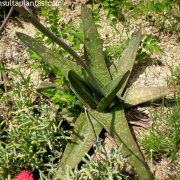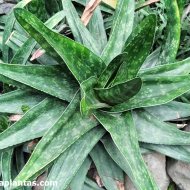Care of the succulent plant Gasteria excelsa or Thicket ox-tongue |
|
The genus Gasteria, family Xanthorrhoeaceae, comprises 80 species of succulent plants native to South Africa. Some species are: Gasteria excelsa, Gasteria disticha, Gasteria carinata, Gasteria bicolor, Gasteria liliputana, Gasteria angustifolia. Common names: Thicket ox-tongue, Regal ox-tongue, Thicket Gasteria. This species is native to Eastern Cape, South Africa. They are medium succulent plants that reach 1 meter (39.37") in height when they bloom. The leaves are fleshy, triangular, dark green with light spots and arranged in a rosette; they have a white and serrated margin. The flowers are pink in color and appear on long flower stalks above the leaves. They bloom from spring to early summer. Thicket ox-tongue is used in borders, in rockeries and in pots for patios and terraces; use large pots because the roots develop a lot. Gasteria excelsa prefers a semi-shade exposure avoiding direct sun in the central hours of the day. It resists light frosts if the substrate is dry. Regal ox-tongue can be grown on poor, sandy soils; it just needs the substrate to be well drained. Water regularly in spring and summer, waiting for the substrate to dry. In autumn reduce watering and in winter water only once a month. Fertilize with compost in fall and mineral fertilizer for cacti and succulents in early spring. Prune off wilted flower stems. Thicket ox-tongue is a sensitive plant to excess of irrigation. Gasteria excelsa propagates by seeds sown in spring or summer and by separation of suckers. |
Images of the succulent plant Gasteria excelsa or Thicket ox-tongue |
Find plants
Gasteria excelsa or Thicket ox-tongue | Care and Growing
© 2026 FavThemes



